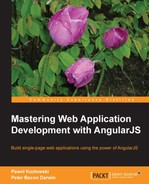Book Description
Streamline your web applications with this hands-on course. From initial structuring to full deployment, you’ll learn everything you need to know about AngularJS DOM based frameworks.
- Make the most out of AngularJS by understanding the AngularJS philosophy and applying it to real life development tasks
- Effectively structure, write, test, and finally deploy your application
- Add security and optimization features to your AngularJS applications
- Harness the full power of AngularJS by creating your own directives
- Full of solutions to real life problems, with clear explanations of the more sophisticated AngularJS concepts
In Detail
AngularJS is an open-source JavaScript framework. Its goal is to develop MVC-based web applications and reduce the amount of JavaScript needed to make web applications functional.
The book will take the reader through the workflow of building an AngularJS app.
Throughout the process of app creation, we will have a look at the different interaction points between design and development and the readers will learn how AngularJS helps both roles to build an application that works well, as well as how to create clean and maintainable front end markup and code.
Table of Contents
- Mastering Web Application Development with AngularJS
- Table of Contents
- Mastering Web Application Development with AngularJS
- Credits
- About the Authors
- Acknowledgments
- About the Authors
- About the Reviewers
- www.PacktPub.com
- Preface
- 1. Angular Zen
- 2. Building and Testing
- 3. Communicating with a Back-end Server
- Making XHR and JSONP requests with $http
- The promise API with $q
- The promise API with $http
- Communicating with RESTful endpoints
- Using advanced features of $http
- Testing code that interacts with $http
- Summary
- 4. Displaying and Formatting Data
- Referencing directives
- Displaying results of expression evaluation
- Conditional display
- Rendering collections with the ngRepeat directive
- DOM event handlers
- Working effectively with DOM-based templates
- Handling model transformations with filters
- Summary
- 5. Creating Advanced Forms
- Comparing traditional forms with AngularJS forms
- Creating a User Information Form
- Understanding the input directives
- Adding the required validation
- Using text-based inputs (text, textarea, e-mail, URL, number)
- Using checkbox inputs
- Using radio inputs
- Using select inputs
- Working with traditional HTML hidden input fields
- Looking inside ngModel data binding
- Validating AngularJS forms
- Nesting forms in other forms
- Repeating subforms
- Handling traditional HTML form submission
- Resetting the User Info form
- Summary
- 6. Organizing Navigation
- URLs in single-page web applications
- Using the $location service
- Using built-in AngularJS routing services
- Limitations of the $route service
- Routing-specific patterns, tips, and tricks
- Summary
- 7. Securing Your Application
- 8. Building Your Own Directives
- What are AngularJS directives?
- Following the directive compilation life-cycle
- Writing unit tests for directives
- Defining a directive
- Styling buttons with directives
- Understanding AngularJS widget directives
- Creating a custom validation directive
- Creating an asynchronous model validator
- Wrapping the jQueryUI datepicker directive
- Summary
- 9. Building Advanced Directives
- Using transclusion
- Creating and working with transclusion functions
- Understanding directive controllers
- Taking control of the compilation process
- Summary
- 10. Building AngularJS Web Applications for an International Audience
- 11. Writing Robust AngularJS Web Applications
- Understanding the inner workings of AngularJS
- Performance tuning – set expectations, measure, tune, and repeat
- Performance tuning of AngularJS applications
- Summary
- 12. Packaging and Deploying AngularJS Web Applications
- Index
